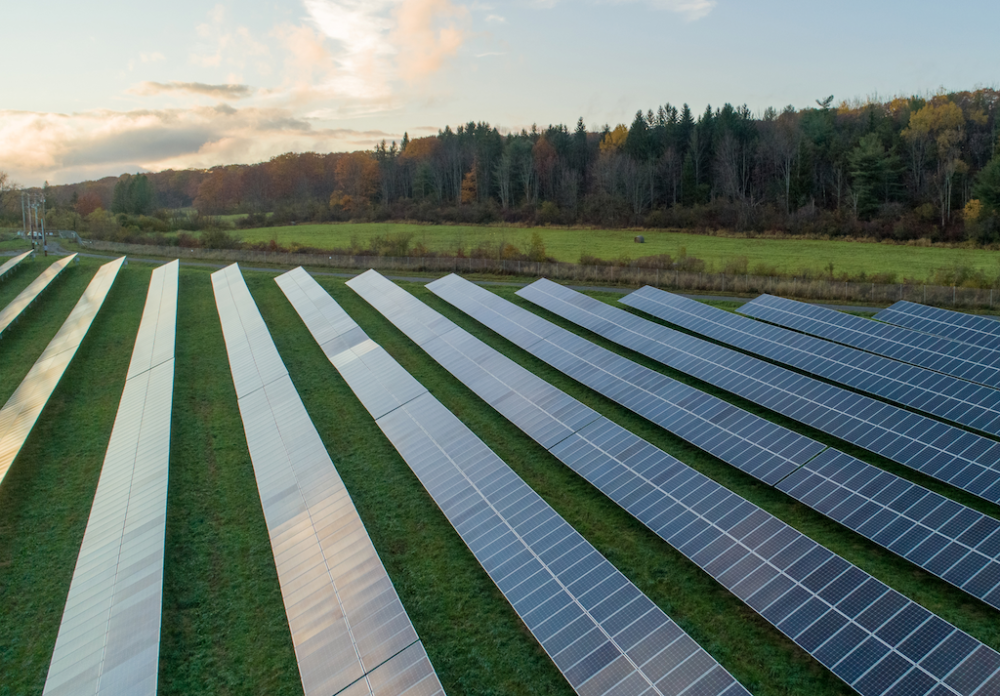The short answer to the carbon problem — or any sustainable initiative — is that everything your company does contributes to a carbon footprint. That includes sending emails, buying lunch for colleagues, taking company trips and even reading this article. Even if your business runs on 100% renewable energy, you’re still caught up in the emissions it takes for employees to commute or bananas to get stocked in the kitchen.
I say that not to deter you, but to put things in perspective. It’s not about setting unrealistic expectations; it’s instead about deciding your company’s priorities and the best way to achieve them — and accepting this as an ongoing process.
Kate Henningsen, COO of DC renewable energy tech-focused Arcadia, noted that sustainable change starts with determining what works for your company.
“In the world of carbon emissions, it’s good to focus on what is best for your business, what you are interested in,” Henningsen told Technical.ly. “What are the things that you want to control, that you want to focus on?”
So, where do you begin? Here are some answers to your questions:
Where to start
After deciding to prioritize eco-friendliness, you’ll have to ascertain what that means to you. That requires picking a starting or focus point, be it plastic waste, carbon or altering the product you’re putting out into the world.
You could decide all of that based on your own priorities, personal values or cost efficiency. Or, you could move to step #2, measuring, to figure out the best starting point. Either way, at some early point, you’ll need to do some math. Sorry.
Peter Fox-Penner, the chief impact officer at Energy Impact Partners (EIP), suggests breaking it down into scope 1 and scope 2 impact measurements.

It’s easier than you might think: just look around your office for what’s emitting. For most companies, calculating scope 1 just requires checking energy purchase receipts that are likely already on hand. Scope two emissions are what’s produced by the company generating your electricity.
But a whole carbon footprint is a little more complicated. If you shifted to remote work over the past few years, you’ve already cut down on commuting emissions. But the company’s total emissions would still include anything your employees use at home. Still, it needn’t be daunting. You can pretty easily multiply an average use by your employee headcount using one of many available calculators. If you have the funds, you could even hire a company to run the numbers for you. Once you do that, it’s pretty easy to find what pain points you should address.
“It’s just a question of collecting them and making some fairly straightforward calculations based on how much energy you bought for use in your company, and that will give you your scope one emissions,” Fox-Penner said. “And as you do that, some pretty logical things occur to you.”
Anjali Mahadevia, an expert in plastic waste reduction and head of strategy and business development for Ampliphi, recommended measuring your plastic waste before deciding the best way to reduce it.
In the office
Once you understand your energy consumption and what you want to change, it’s time to make moves. Many companies’ natural starting point requires seeing where their energy comes from and deciding if they should switch to a greener source. For those renting in a large building or even a coworking space, Fox-Penner suggested speaking with other tenants and approaching the building owner about possibly transitioning to cleaner energy.
Most tech companies won’t achieve net zero without carbon offsets, which have their own pros and cons (namely that they only prevent an increase in future carbon, instead of reducing the overall amount, and the difficulty of verifying how well your offsetter company does its job). But some recommended options exist.
Unfortunately, there’s little to do if your employees all work remotely, but you can get creative. Consider offering incentives for employees who buy clean energy or install solar panels on their roofs, as well as just making information about clean energy front and center.
On a smaller scale, Fox-Penner said EIP encourages its employees to commute using public transportation and to buy electric vehicles. When employees travel, the company recommends using an all-electric taxi service (he also said that opting for a Zoom meeting or even an email counts as a sustainable switch). EIP is also making Microsoft its IT provider, given its strong clean energy commitments. At the office, Fox-Penner said leadership is also prioritizing green caterers and food suppliers, as well as emphasizing vegetarian and vegan meals, given the meat industry’s carbon and deforestation impacts.

He noted that working with companies with similar ideologies can apply to any aspect of a company’s business — for instance, even working with law firms that set vital offsetting goals for compliance needs.
Mahadevia, whose employer helps companies lower their plastic waste, suggested that companies simply add a compost bin (there are many pickup services available) and signs clarifying what should be trashed and recycled.
While some of these measures might seem like extra costs, Mahadevia noted that they’re valuable for consumers. Simon-Kucher & Partners’ 2021 Global Sustainability Study found that 85% of people indicate having shifted to more sustainable purchasing.
“Profit and planet are correlated, they’re not separate,” Mahadevia said. “And if you are working for the planet, that will actually increase your profit because the world cares, consumers care.”
Becoming a green tech company
Reducing carbon is easier in tech than in other industries. New companies especially, Henningsen noted, can build climate right into the product. For others, it might take a little more finagling but it is still possible.

Code itself, Henningsen said, can be written so that it doesn’t need to pull data constantly, which reduces stress on the server. A solution Arcadia created in a hackathon involved writing code to optimize data pulling during time blocks when energy is cleaner; since renewables fluctuate, there are times when the grid doesn’t need to supplement as much with coal and gas power.
“It may not sound sexy, but figuring out how you can make your data run at times where there’s more renewable energy is a thing that all tech companies should be able to do, even small ones,” Henningsen said.
If that won’t work, she recommended ensuring that the energy needed to run servers and support data is as clean as possible. Arcadia manages over a gigawatt of community solar — smaller projects often owned by residents. But it’s also important, she said, to put pressure on those holding power that’s out of direct control.
“Tech should be pressuring their suppliers,” Henningsen said. “They should be holding Amazon accountable for making the data centers green, for Google being green…I think that’s where, really, tech companies should lean in and say, ‘Every data set you view should be green,’ and really [push] the companies to do that. I think that’s a powerful thing to do.”
For those trying to lower plastic waste, Mahadevia recommends transparency with consumers. That could mean adding more information on the package so users know what it’s made of and if it can be recycled without more research. Companies can also switch to materials that are either recyclable, compostable or made from recycled products.
If you can’t achieve all that in one go, though, she emphasized that cleaning up a company isn’t about being perfect. Net zero, she said, is not about having no waste, but rather about being as eco-conscious as possible to the best of your abilities.
“Don’t just do it for show, do it because, for the long term, it’s more sustainable for profit and for the planet,” Mahadevia said. “Not only will you drive more consumers because you’re authentic to the message that you’re sending, but you’ll be more sustainable.”







